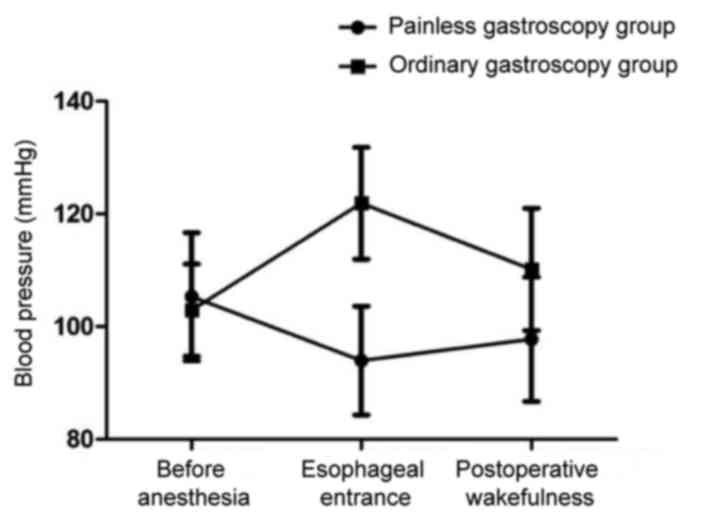Comparison of the safety of the application of painless gastroscopy and ordinary gastroscopy in chronic hypertension patients combined with early gastric cancer
- Authors:
- Published online on: January 5, 2018 https://doi.org/10.3892/ol.2018.7737
- Pages: 3558-3561
-
Copyright: © Men et al. This is an open access article distributed under the terms of Creative Commons Attribution License.
Metrics: Total
Views: 0 (Spandidos Publications: | PMC Statistics: )
Total PDF Downloads: 0 (Spandidos Publications: | PMC Statistics: )
Abstract
The aim of the present study was to compare the safety of the application of painless gastroscopy and ordinary gastroscopy for chronic hypertension patients combined with early gastric cancer. A total of 123 patients with early gastric cancer were selected at the Dongying People's Hospital from June, 2014 to August, 2016. The patients were randomly divided into the painless (n=63) and ordinary (n=60) gastroscopy groups. Proper pretreatment was performed according to whether anesthesia was performed or not. Arterial pressure, heart rate, and blood oxygen saturation were detected and compared before anesthesia, when gastroscope passed through the esophageal entrance plane, and after recovery from anesthesia. The incidence of nausea and vomiting, cough, dysphoria, throat discomfort and other adverse reactions during and after surgery were recorded and compared. Compared with the levels before anesthesia, the mean arterial pressure, heart rate and blood oxygen saturation were significantly reduced in painless gastroscopy when the gastroscope passed through the esophageal entrance plane (P<0.05). In the ordinary gastroscopy group, the mean arterial pressure, heart rate and blood oxygen saturation were significantly increased when the gastroscope passed through the esophageal entrance plane compared with the levels before anesthesia (P<0.05). Blood pressure decreased in the painless gastroscopy group whereas it increased in the ordinary gastroscopy group after anesthesia. The decrease in the painless gastroscopy group was lower than in the ordinary group. The incidence of intraoperative and postoperative adverse reactions including nausea, vomiting, cough, dysphoria, pharyngeal discomfort and other adverse reactions was significantly decreased in the painless gastroscopy group than in the ordinary gastroscopy group (P<0.05). The results suggest that the application of painless gastroscopy in chronic hypertension patients can significantly reduce the incidence of intraoperative and postoperative adverse reactions compared with that of the Gastric cancer ordinary gastroscopy. Thus, painless gastroscopy is safer than ordinary gastroscopy.











